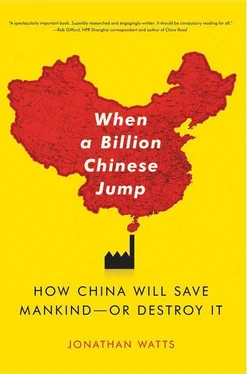We checked into the Paradise Hotel, which was decorated with plastic azaleas. Its main feature was a pool that was rarely used because exercise is not recommended for visitors to an altitude of 3,300 meters. Nearby, an “old town” was being built almost from scratch. Carpenters were busy hewing timber beams and erecting curved roofs and tapering balustrades. Their work was part of a 300-million-yuan makeover aimed at making the town look less like Zhongdian and more like Shangri-La. The faux-antique decoration was the epitome of modernity. Some of the elegantly carved wooden buildings were already completed and full of trinket sellers offering fluffy yaks, prayer beads, and ceremonial daggers. On the new cobbled streets, black-market hawkers touted fake Rolex watches and Ray-Ban sunglasses.
We entered a Tibetan restaurant and ordered tsampa. Two beggars wandered from table to table asking for money. They got short shrift from the only other customers, a group of soldiers, who were reluctant to interrupt a drinking game that had one of them throwing up beside the table. “Don’t bother us. Go and ask the foreigner for money,” they said as they shooed the beggars away. Tired and grumpy after the long drive, I couldn’t help feeling that the closer you got to Shangri-La, the farther away it seemed from Utopia.
I returned to the hotel dispirited, but other hotels guests were in a party mood. Next to my room, flashing red neon tubes illuminated the way to the Paradise karaoke bar, where hostesses were on offer for a fee: 100 yuan to sing together for an hour, 200 yuan for a shared dance, more for something extra. Shangri-La’s attractions came in many forms.
At a hot-pot lunch the next day with A Wa, the chief of the local tourist bureau, I got a clear idea of the government’s priorities: “We have two targets: promoting economic development and raising people’s incomes, both of which we hope to achieve through tourism.”
Between tasty bites of yak meat and mountain vegetables I had never seen before, A told me money and class would solve Zhongdian’s environmental problems. The region aimed to attract more middle- and high-end tourists because they spend and consume more, yet waste and pollute less. This was the same environmental compromise sought by growth-obsessed governments across the world: it was the essence of the “pollute first, clear up later” outlook on development. But, I wondered aloud, didn’t this still lead to the clearance of forests and grassland, the drawing of more water, and increased demand for timber, concrete, and other building materials? How could it be called a formula for sustainability? A answered that people’s welfare was the priority.
Until recently, trees had taken the brunt of developmental stress. Yunnan’s forest cover had halved since 1950. 26Although the government introduced tight logging restrictions in 1998, just a few years later timber companies were felling 40 million square meters of forest, almost fifty times the permitted limit. 27Since then, efforts to reverse the destruction had been compromised by Yunnan’s shift toward cash crops. By the Burmese border, the ecologically rich tropical rain forests of Xishuangbanna—one of the last homes of elephants in China—were steadily being replaced by rubber and sugarcane plantations. 28In Simao, ancient pines were felled for a project to convert 1.8 million hectares of land for fast-growing eucalyptus cultivation by Asia Pulp & Paper, the region’s biggest tree chomper.
It was a poor long-term investment. Old forests were filled with life accumulated over thousands of years. Their biodiversity and vitality enabled them to cope with invasive species just as a body on a balanced diet is better able to withstand illness. The rows of new monoculture trees, however, were felled every ten years or so. Little life could be nourished beneath their temporary canopy and the trees often succumbed to the invading competitors. Not for nothing were these plantations called “green deserts.”
Environmentalists believe we need to look back to move forward. Bob Moseley, an expert in alpine ecology who set up the Nature Conservancy’s Yunnan programs, sees traditional beliefs and customs as the best hope for the sustainable management of the land and forests. This runs contrary to the prevailing wisdom in top-down, technocratic China, where poor, uneducated villagers are often blamed for gathering so much firewood that forests are depleted. Moseley has used repeat photography to back his counterargument. He collected more than a thousand old photographs of northwest Yunnan spanning 100 years and commissioned new pictures to be taken at the same spots. The comparisons suggest forest cover around indigenous communities has been constant—and in many cases increased—as a result of sensible limits on wood gathering and tree felling. In contrast, government-backed programs of old-growth cutting, clearance for rubber plantations, and forest conversion to monoculture have taken a heavy toll. His conclusion is that “millennia of accumulated ecological knowledge among local people has a lot to tell us about how to manage for biodiversity in the future.” 29
Chinese scholars recognize that indigenous groups have a better appreciation of “useless trees.” Botanists and forestry experts at the Kunming Institute of Botany see the worship of holy mountains and trees as a means by which locals promote sustainability. From a study of Yunnan, they conclude that minorities take better care of nature than majorities. 30
Historical documents show that the province had a system of elected forest guardians and logging quotas as far back as the Qing dynasty. The epigraph at the start of this chapter was inscribed on a monument in Yunnan from 1714. It appeals for the preservation of forest ecosystems in terms that sound very similar to those used by green activists today. 31
Everyone understands that only healthy green forests and fertile soil can nurture ever-flowing springs. None doubts the significance of those fundamental elements of nature, such as soil, water, and fire. Yet, do we know it is the root of trees and forest that bring us water? It is for our benefit and fortune.
The mountains I saw in Yunnan were being stripped bare, but this time it was ice rather than forest cover that was disappearing. Glaciers were melting and retreating so fast that local monks blamed themselves for being insufficiently pious. 32The forest and grasslands are also being overexploited for mushrooms. I had never imagined how huge this fungal industry was until I set out from Zhongdian to see another of the candidates that had fought the Shangri-La contest.
Yading, a few hundred kilometers north across the border with Sichuan Province, was the most remote yet. After we left the resort areas, the clouds lifted, the forest thickened, and the valley road climbed past brightly colored Tibetan farmhouses. People here were clearly making money. Many of the huge homes were newly built. Shafts of sunlight made the bare timber shine almost as brightly as the fresh paint.
They were paid for by the global mushroom economy. We saw our first roadside fungus hawkers an hour outside of Zhongdian. It was grueling work for the collectors: twelve hours a day scouring the hillsides for the slim, 2-centimeter stemlike protuberance that is all of the fruit that sticks out of the earth. On a good day, they said they could find five fungi that they could sell for about 15 yuan each.
Yunnan is home to 87 percent of all the fungi found in China. 33With strong demand from overseas and more Chinese able to afford such exotica, northwest Yunnan and other Tibetan areas are in the midst of a fungal gold rush. The province’s most lucrative agricultural export market was Matsutake pine mushrooms, prized in Japan for their fragrance and taste. Consumers in Tokyo and Kyoto were willing to pay up to 10,000 yen (US$110) for the best specimens. 34Chinese consumers preferred the caterpillar fungus Cordyceps sinensis, which consumed its host, the ghost moth caterpillar, from inside out as it hibernated on the mountain grasslands. But rising demand and intense competition is driving foragers to collect earlier in the year, sometimes before the fungus has had time to release spores. This means it has no way to reproduce. Production has plummeted over the past twenty years, driving up the price of the fungus to almost twice the price of gold, gram for gram. 35Many Chinese believe this ghoulish parasite, known in Tibetan as yartsa gunbu, or bu, is variously a cure for cancer, an aphrodisiac, and a tonic for long-distance runners.
Читать дальше










